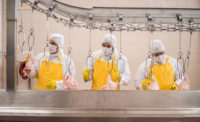Though recent reductions of capital spending industry-wide have slowed the growth of in-package pasteurization systems, the technology is continuing to become part of the mainstream. In the process, products are partially cooked or smoked to provide the necessary smoke color and make the product firm enough to handle. Then, they are taken from the dry-heat system, packaged and put through a hot-water pasteurization and cold-water chill system. The benefits to the system are significant, in that it eliminates the handling of product once it has been cooked, and therefore eliminates the risk of post-cook contamination.
“The food-safety side of this is really unmatched, because you have no ready-to-eat area in a system like that,” says Bob Hanson, founder of HansonTech, a consultant firm that specializes in thermal processing of meat products. A plant that converted completely to this approach, he says, would only have raw areas and packaged areas, with no chance of post-cook contamination.
“As such, a converted plant would have a significant manufacturing, food safety, regulatory and yield advantage over conventional plants,” he says.
Jeff Sindelar, assistant professor/extension meat specialist at the Meat Science & Muscle Biology Laboratory at the University of Wisconsin-Madison, notes that this relatively recent technique relies on an extremely time-tested cooking method.
“Cook-in-bag technology is a great way of taking old technology, which is water — one of the best mediums for heat transferability and cooking — and applying that to a product where you can maximize quality, shelf life and food safety, just by adjusting your process,” he says.
“The trick is, how do you do that and still make the wide variety of products that are made, and make them with the characteristics and properties that we see today,” Sindelar adds.
Dr. Cathy Cutter, associate professor and food safety extension specialist-muscle foods at Penn State University, said that she has worked with a processor that incorporated a cook-in-bag and chilling process in its facility. As a result, the company was able to land a large retail contract, thanks to the food-safety benefits of the process as well as the quality of the end product.
“We have to marry the safety issues with the quality, because you can do everything [to ensure food safety], but if it doesn’t look right, nobody’s going to buy it,” she says.
Cutter notes that the technology is not just for companies with large capital-expenditure budgets, either.
“This has potential for even small processors, if you can build a system and make it do everything you want,” she says, referring to a processor she knows who found commercial systems too expensive. “So he took some of the parameters and built it himself.”
Currently, most of the products made using cook-in-bag technology are links, but it could be expanded to include items such as non-sliced deli meats and hams, Hanson notes. The process itself can also be adapted to either a continuous or a batch process.
“The in-package pasteurization process itself is independent of the machinery, and so it is readily adapted to batch processes,” he explains.
While cook-in-bag technology has shown considerable promise, processors must take steps to ensure that they are doing it correctly. Cutter notes that any company looking to utilize the technology must make sure that it is using the right film in its packaging.
“You’ve got to work with your packaging film company to make sure it can withstand the heat and chilling that goes with [cook-in-bag technology],” she says. “You’ve got to do the background work to make sure you’ve got film that meets the right temperatures, that it withstands them for the period of time that you’re going to be cooking, and that you’re not going to have a release of chemicals.”
She adds that each product cooked with the technology will need its own cooking and chilling times, which will require a significant amount of in-plant data generation.
Cooking up new ideas
While in-package pasteurization has come on strong in recent years, there are a wide variety of cooking methods available, and plenty of cooking equipment in the market for processors.
“If you’re making a typical cooked sausage, say a frankfurter, you could purchase equipment depending on your facilities, your line speeds, your volume, how much money you have, the direction you think your company is going to go in the future,” says Sindelar. “That might range anywhere from a simple gravity-flow house to a smokehouse, where you’ve got better control over humidity, to a continuous oven.”
Straight-line impingement ovens have been popular for ready-to-eat products, such as sausage patties and chicken breasts. Hanson notes that the impingement ovens have dominated the rapid-cook end of cooked meats for a long time, but he has seen spiral ovens gaining in popularity.
“Impingement ovens used to have a significant edge over spiral ovens for products that needed more browning, but newer airflow designs in spirals have narrowed the gap on browning capabilities,” he says, “and spiral ovens can now make most products that are made in impingement ovens.”
The obvious advantage of the spiral ovens is the reduced footprint.
“Processors are always looking to use the height of the building instead of a larger footprint, because of the increased building costs [of expanding]” Hanson says. “By going vertical, they can use the less expensive building space.”
Hanson adds that most spiral cookers have two cooking zones, which increases their capacity. The higher capacity allows processors to cook products for a little longer than they would in a linear impingement oven.
“The higher-capacity system allows you to ease off the gas pedal and not have to push the product so hard to get a reasonable capacity out of the oven,” he says. “With impingement ovens, you’re always pushing them as hard as you can, because getting a reasonable capacity out of those systems is much more challenging.”
Despite the longer cooking times, a spiral oven can produce higher yields, and the longer cook time can also lead to higher lethality of pathogens, he says. The disadvantage, however, lies in the complexity of a spiral oven versus a linear one.
“A straight belt is easier to maintain than a spiral belt,” Hanson says. “Even if it’s well-built, there are inherently more parts and more wear areas, and having a belt go in a spiral is harder on a belt, so it will generally be higher maintenance.”
When making an evaluation of linear or spiral ovens, Hanson notes that the yield and capacity advantages of a spiral oven and the reduced construction costs have to offset the higher maintenance costs.
Cooking technology continues to evolve, shortening cook times and improving food safety. Sindelar notes that a European company has been manufacturing cooking equipment for a dried sausage that stuffs, crust-freezes, chills, slices, thermo-processes and dries it.
“They’re able to speed up the drying process quite a bit,” he notes. “You’re essentially going from days and weeks of drying to minutes and hours.”
One of the biggest improvements in cooking technology is the ability to have better controls, which results in more uniform cooking. Sindelar says that future improvements in the technology will help improve that consistency, though it can be an uphill struggle.
“With cooking and cooling, you’re battling product quality, maintaining good cook yields and good throughputs, safety, and you’re battling all that with raw materials, ingredients and processing conditions — such as environmental temperatures — that vary,” he explains. “Regardless of how hard you try, you constantly have a little variation from batch to batch and lot to lot. Most times it’s very minimal, but there’s still a little bit there.”
In the meantime, processors can still do much to optimize their existing cooking equipment as much as possible. Hanson points out that the industry’s tendency to get the most out of its cooking machines rather than buy new models, as well as the current economic situation that has stalled some purchases, has made operators more knowledgeable about airflow and process optimization.
“If you can just turn a few knobs and make small airflow adjustments to increase plant throughputs instead of buying new capacity, the return on investment is remarkable,” he says.
Keeping airflow in balance is one way to keep an oven running as efficiently as possible. Impingement and spiral ovens have airflows with more of a fixed pattern, so they don’t tend to go out of balance as often as smokehouses. Smokehouses, due to their nature, have the potential for variation from top to bottom, side to side, and/or front to back, whereas products on a belt can only have side-to-side variation across the belt.
“What I tell my clients is that most ovens are stealing money from you, in the form of out-of-balance airflow, which results in excess evaporation, which is money out the stack that you could have kept in the product and sold,” Hanson says.
Chilling developments
The chilling process goes hand-in-hand with the cooking process, and there have been many efforts made to improve that system as well. Not every attempt worked. Hanson notes that when hot products enter a cold environment, moisture wants to evaporate from it. Some processors have tried to minimize that evaporation by keeping a high humidity in the chiller, an effort that Hanson calls misguided. The humidified chillers used above-freezing temperatures to prevent coil freeze-up, but the warmer air actually slowed the cooling rate of the chiller and actually increases cooler losses.
“The key to reducing cooler loss is to get the product cold as fast as you can,” he explains. “Once a product is cold, it’s not near as prone to losing moisture. High humidity in the system really doesn’t help.”
Blast-chill cells have become more common in the last three to five years, and the most recent designs are equipped with higher air velocities to maximize chilling rates and reduce cooler shrink.
“I have found that the best designs are those that deliver an air velocity of 400 feet/minute or higher across all product surfaces in all areas of the chiller,” Hanson says.
Another development is the use of dedicated blast chillers, which may only accommodate one or two smokehouses instead of an entire facility’s worth of products. Those products are then moved into a holding cooler when ready. The holding cooler, Hanson notes, is designed to keep products cool and not chill them down, so any company that is attempting to use a holding cooler as a chiller will not see effective results.
Brine chillers are commonly used for high-speed, high-volume applications, when the processor needs to chill products rapidly.
“They use a water brine to lower the freezing temperature of the water, and you get very efficient chilling,” says Sindelar.
In order to promote good sanitation, the brine should be treated with either chlorine or citric acid to eliminate salt-tolerant pathogens such as Listeria monocytogenes, Hanson says.
“All chillers should be highly cleanable, so that exposed RTE products are not cross-contaminated with pathogenic or spoilage bacteria during chilling,” he adds.
Incidentally, using in-pasture pasteurization for cooking products will also aid in chilling them as well.
Since products are already in their package when they are put into the chiller, those products will not lose any further moisture. The net result is higher yield and the elimination of cooler shrink.








